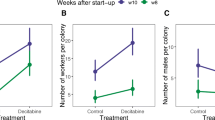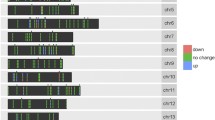Abstract
The principal mechanism of gene activation/silencing is DNA 5-methylcytosine methylation. This study was aimed at determining global DNA methylation levels in larvae, prepupae, pupae, and 1-day-old adults of Apis mellifera queens, workers and drones. The Imprint Methylated DNA Quantification Kit MDQ1 was used. Percentages of DNA 5-methylcytosine were low and relatively similar in the larvae of all the castes until 4th day of larval development (3–5%). However, they were higher in the drone and worker larvae than in the queen larvae. Generally, the developmental patterns of changes in the DNA methylation levels were different in the queens in comparison with the drones and workers. While methylation increased in the queens, it decreased in the drones and workers. Methylated DNA methylcytosine percentages and weights in the queen prepupae (15%, 9.18 ng) and pupae (21%, 10.74 ng) were, respectively, three and four times higher than in the worker/drone brood of the same age (2.5–4%, 0.03–0.07 ng). Only in the queens, after a substantial increase, did DNA methylation decrease almost twice between the pupal stage and queen emergence (from 21% and 10.74 ng to 12% and 6.78 ng). This finding seems very interesting, particularly for experimental gerontology.
Similar content being viewed by others
References
Foret, S., Kucharski, R., Pittelkow, Y., Lockett, G., and Maleszka, R. (2009) Epigenetic regulation of the honeybee transcriptome: unravelling the nature of methylated genes, BMC Genom.; http://dx.doi:10.1186/1471-2164-10-472.
Bocklandt, S., Lin, W., Sehl, M. E., Sanchez, F. J., Sinsheimer, J. S., Horvath, S., and Vilain, E. (2011) Epigenetic predictor of age, PLoS, 6, 1–6.
Bird, A. (2002) DNA methylation patterns and epigenetic memory, Gene Dev., 16, 6–21.
Suzuki, M. M., Kerr, A. R. W., De Sousa, D., and Bird, A. (2007) CpG methylation is targeted to transcription units in an invertebrate genome, Genome Res., 17, 625–631.
Rogalska, S. M., Achrem, M., and Wojciechowski, A. (2010) Chromatyna. Molekularne Mechanizmy Epigenetyczne [in Polish], Wydawnictwo UP, Poznan, pp. 15–80.
Kucharski, R., Maleszka, J., Foret, S., and Maleszka, R. (2008) Nutritional control of reproductive status in honeybees via DNA methylation, Science, 319, 1827–1830.
Barchuk, A. R., Cristino, A. S., Kucharski, R., Costa, L. F., Simoes, Z. L., and Maleszka, R. (2007) Molecular determinants of caste differentiation in the highly eusocial honeybee Apis mellifera, BMC Dev. Biol., 7, http://dx.doi:10.1186/1471-213X-7-70.
Patel, A., Fondrk, M. K., Kaftanoglu, O., Emore, C., Hunt, G., Frederic, K., and Amdam, G. (2007) The making of a queen: TOR pathway is a key player in diphenic caste development, PLoS One, 2; http://dx.doi:10.1371/journal.pone.0000509.
Maleszka, R. (2008) Epigenetic integration of environmental and genomic signals in honeybees, Epigenetics, 3, 188–192.
Kamakura, M. (2011) Royal actin induces queen differentiation in honeybees, Nature, 473, 478–483.
Shi, Y. Y., Huang, Z. Y., Zeng, Z. J., Wang, Z. L., Wu, X. B., and Wei, Y. Y. (2011) Diet and cell size both affect queen–worker differentiation through DNA methylation in honey bees (Apis mellifera, Apidae), PLoS One, 6; http://dx.doi:10.1371/journal.pone.0018808.
Evan, J., and Wheeler, D. (2000) Expression profiles during honeybee caste determination, Genome Biol., 2; http://dx.doi:10.1186/gb-2000-2-1-research0001.
Burzynski, S., Paleolog, J., Patii, S., Ilkowska-Musial, E., Borsuk, G., Olszewski, K., Chittur, S., Gupta, V., Sarangi, R., and Strachecka, A. (2013) Changed gene expression and longevity in honeybees (Apis mellifera) fed with phenylbutyrate- and phenylacetylglutaminate-supplemented diet, Med. Weter., 69, 753–759.
Wheeler, M., and Robinson, G. (2014) Diet-dependent gene expression in honeybees: honey vs. sucrose or high fructose corn syrup, Sci. Rep., 4, 5726.
Strachecka, A., Borsuk, G., Olszewski, K., Paleolog, J., Gagos, M., Chobotow, J., Nawrocka, A., Gryzinska, M., and Bajda, M. (2012) The effect of amphotericin B on the lifespan, body surface protein concentrations and DNA methylation level of the honeybees (Apis mellifera), J. Apic. Sci., 56, 107–113.
Strachecka, A., Gryzinska, M., and Krauze, M. (2010) The influence of environmental pollution on the protective proteolytic barrier of the honeybee Apis mellifera mellifera, Pol. J. Environ. Stud., 19, 855–859.
Strachecka, A., Krauze, M., Olszewski, K., Borsuk, G., Paleolog, J., Merska, M., Chobotow, J., Bajda, M., and Grzywnowicz, K. (2014) Unexpectedly strong effect of caffeine on the vitality of western honeybees (Apis mellifera), Biochemistry (Moscow), 79, 1192–1201.
Strachecka, A., Olszewski, K., Krauze, M., Paleolog, J., Borsuk, G., Merska, M., Bajda, M., and Chobotow, J. (2014) Coenzyme Q10 treatments influence the lifespan and key biochemical resistance systems in the honeybee, Apis mellifera, Arch. Insect Biochem. Physiol., 86, 165–179.
Strachecka, A., Paleolog, J., Borsuk, G., and Olszewski, K. (2012) Influence of formic acid on the body surface proteolytic system in different developmental stages of Apis mellifera L. workers, J. Apic. Res., 51, 252–262.
Strachecka, A., Paleolog, J., Borsuk, G., Olszewski, K., and Bajda, M. (2012) DNA methylation in the honeybee (Apis mellifera) and its importance for biological research, Med. Weter., 68, 391–396.
Lyko, F., Foret, S., Kucharski, R., Wolf, S., Falckenhayn, C., and Maleszka, R. (2010) The honeybee epigenomes: differential methylation of brain DNA in queens and workers, PloS Biol., 8, 1–12.
Shi, Y., Yan, W., Huang, Z., Wang, Z., Wu, X., and Zeng, Z. (2013) Genomewide analysis indicates that queen larvae have lower methylation levels in the honey bee (Apis mellifera), Naturwiss., 100, 193–197.
Cedar, H., and Bergman, Y. (2009) Linking DNA methylation and histone modification: patterns and paradigms, Nat. Rev. Genet., 10, 295–304.
Miklos, G., and Maleszka, R. (2011) Epigenomic communication systems in humans and honeybees: from molecules to behavior, Horm. Behav., 59, 399–406.
Hartfelder, K., Tozetto, S., and Rachinsky, A. (1993) Sexspecific developmental profiles of juvenile hormone synthesis in honeybee larvae, Roux’s Arch. Dev. Biol., 202, 176–180.
Winston, M. (1987) The Biology of Honeybee, Harvard University Press, Cambridge, pp. 46–213.
Harfelder, K., and Engels, W. (1998) Social insect polymorphism: hormonal regulation of plasticity in development and reproduction in the honeybee, Curr. Top. Dev. Biol., 40, 45–77.
Evans, J., and Wheeler, D. (1999) Differential gene expression between developing queens and workers in the honey bee Apis mellifera, Proc. Natl. Acad. Sci. USA, 96, 5575–5580.
Wheeler, D., Buck, N., and Evans, J. (2006) Expression of insulin pathway genes during the period of caste determination in the honey bee Apis mellifera, Insect Mol. Biol., 15, 597–602.
Wolschin, F., Mutti, N. S., and Amdam, G. V. (2011) Insulin receptor substrate influences female caste development in honeybees, Biol. Lett., 7, 112–115.
Rascon, B., Mutti, N., Tolfsen, C., and Amdam, G. (2011) in Mechanisms of Life History Evolution. Honeybee Life History Plasticity: Development, Behavior, and Aging (Flatt, T., and Heyland, A., eds.) Vol. 1, Oxford University Press Inc., New York, pp. 253–266.
Page, R., Scheiner, R., Erber, J., and Amdam, G. (2006) The development and evolution of division of labor and foraging specialization in a social insect (Apis mellifera L.), Curr. Top. Dev. Biol., 74, 253–286.
Amdam, G., Ihle, K., and Page, R. (2009) in Hormones, Brain and Behavior. Regulation of Honeybee (Apis mellifera) Life-Histories by Vitellogenin (Pfaff, D., Arnold, A., Fahrbach, S., Etgen, A., and Rubin, R., eds.) Vol. 4, Elsevier Academic Press, San Diego, pp. 1003–1025.
Beye, M., Hunt, G. J., Page, R. E., Fondrk, M., Grohmann, L., and Moritz, R. (1999) Unusually high recombination rate detected in the sex locus region of the honeybee (Apis mellifera), Genetics, 153, 1701–1708.
Ikeda, T., Furukawa, S., Nakamura, J., Sasaki, M., and Sasaki, T. (2011) CpG methylation in the hexamerin 110 gene in the European honeybee Apis mellifera, J. Insect Sci., 74, 1–11.
Lyko, F., and Maleszka, R. (2011) Insect as innovative models for functional studies of DNA methylation, Trends Genet., 27, 127–164.
Shao, X., He, S., Zhauang, X., Fan, Y., Li, Y., and Yao, Y. (2014) mRNA expression and DNA methylation in three key genes involved in caste differentiation in female honeybees (Apis mellifera), Zool. Res., 35, 92–98.
Cornman, R., Schatz, M., Johnston, J., Chen, Y., Pettis, J., Hunt, G., Bourgeois, L., Elsik, C., Anderson, D., Grozinger, C., and Evans, J. (2010) Genomic survey of the ectoparasitic mite Varroa destructor, a major pest of the honeybee Apis mellifera, BMC Genom., 11, http://dx.doi:10.1186/1471-2164-11-602.
Fries, I. (2010) Nosema ceranae in European honeybees (Apis mellifera), J. Invert. Pathol., 103, 573–579.
Ptaszynska, A. A., Borsuk, G., Wozniakowski, G., Gnat, S., and Malek, W. (2014) Loop-mediated isothermal amplification (LAMP) assays for rapid detection and differentiation of Nosema apis and N. ceranae in honeybees, FEMS Microbiol. Lett. Fed. Europ. Microbiol. Sci., 357, 40–48.
Author information
Authors and Affiliations
Corresponding author
Additional information
Published in Russian in Biokhimiya, 2015, Vol. 80, No. 8, pp. 1215–1223.
Originally published in Biochemistry (Moscow) On-Line Papers in Press, as Manuscript BM14-326, February 22, 2015.
Rights and permissions
About this article
Cite this article
Strachecka, A., Olszewski, K., Bajda, M. et al. Natural larval diet differently influences the pattern of developmental changes in DNA 5-methylcytosine levels in Apis mellifera queens as compared with workers and drones. Biochemistry Moscow 80, 1019–1025 (2015). https://doi.org/10.1134/S0006297915080076
Received:
Revised:
Published:
Issue Date:
DOI: https://doi.org/10.1134/S0006297915080076




